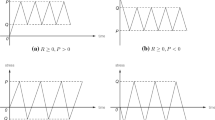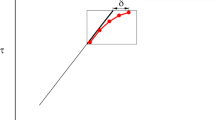Abstract
A new finite \(J_2-\)flow rate-dependent elastoplastic model is proposed toward directly simulating cyclic and non-cyclic fatigue failure behavior of metals. Novel results in four respects are presented: (1) the concept of yielding is rendered irrelevant with smooth transitions to both the plastic state and the rate-independent case; (2) asymptotic loss of the strength is incorporated as inherent constitutive feature; (3) the failure behavior may accordingly be derived as a direct consequence of the proposed model, without involving any additional failure criteria and any additional variables; and (4) direct and explicit procedures are established for identifying each rate-dependent parameter based on suitable test data. Numerical examples are provided for various uniaxial loading cases up to failure, including monotone and cyclic strain cases from low to high strain rates and cyclic loading cases as well as non-cyclic loading cases with either variable stress amplitudes or variable strain rates. Model predictions compare well with test data.
Similar content being viewed by others
References
Argon, A.S.: Topics in Fracture and Fatigue. Springer, Berlin (2011)
Bonora, N., Gentile, D., Pirondi, A., Newaz, G.: Ductile damage evolution under triaxial state of stress: theory and experiments. Int. J. Plast. 21, 981–1007 (2005)
Bruhns, O.T., Xiao, H., Meyers, A.: Self-consistent Eulerian rate type elasto-plasticity models based upon the logarithmic stress rate. Int. J. Plast. 15, 479–520 (1999)
Bruhns, O.T., Xiao, H., Meyers, A.: Some basic issues in traditional Eulerian formulations of finite elastoplasticity. Int. J. Plast. 19, 2007–2026 (2003)
Bruhns, O.T., Xiao, H., Meyers, A.: A weakened form of Ilyushins postulate and the structure of self-consistent Eulerian finite elastoplasticity. Int. J. Plast. 21, 199–219 (2005)
Brünig, M.: An anisotropic ductile damage model based on irreversible thermodynamics. Int. J. Plast. 19, 1679–1713 (2003)
Brünig, M.: Numerical analysis of anisotropic ductile continuum damage. Compt. Meth. Appl. Mech. Eng. 192, 2749–2776 (2003)
Brünig, M.: A continuum damage model based on experiments and numerical simulations-A review. In: Altenbach, H., Matsuda, T., Okumura, D. (eds.) From Creep Damage Mechanics to Homogenization Methods - A Liber Amicorum to Celebrate the Brithday of Nobutada Ohno. Advanced Structural Materials Series, pp. 19–35. Springer, Berlin (2015)
Brünig, M., Chyra, O., Albrecht, D., Driemeier, L., Alves, M.: A ductile damage criterion at various stress triaxialities. Int. J. Plast. 24, 1731–1755 (2008)
Brünig, M., Gerke, S.: Simulation of damage evolution in ductile metals undergoing dynamic loading conditions. Int. J. Plast. 27, 1598–1617 (2011)
Brünig, M., Gerke, S., Hagenbrock, V.: Micro-mechanical studies on the effect of the stress triaxiality and the Lode parameter on ductile damage. Int. J. Plast. 50, 49–65 (2013)
Brünig, M., Ricci, S.: Nonlocal continuum theory of anisotropically damaged metals. Int. J. Plast. 21, 1346–1382 (2005)
Chung, K., Ma, N., Park, T., Kim, D., Yoo, D., Kim, C.: A modified damage model for advanced high strength steel sheets. Int. J. Plast. 27, 1485–1511 (2011)
Giroux, P., Dalle, F., Sauzay, M., Malaplate, J., Fournier, B., Gourgues-Lorenzon, A.: Mechanical and microstructural stability of P92 steel under uniaxial tension at high temperature. Mater. Sci. Eng. A 527, 3984–3993 (2010)
Koster, M., Lis, A., Lee, W.J., Kenel, C., Leinenbach, C.: Influence of elasticplastic base material properties on the fatigue and cyclic deformation behavior of brazed steel joints. Int. J. Fatigue 82, 49–59 (2016)
Macha, E., Nieslony, A.: Critical plane fatigue life models of materials and structures under multiaxial stationary random loading: The state-of-the-art in Opole Research Centre CESTI and directions of future activities. Int. J. Fatigue 39, 95–102 (2012)
Malcher, L., Pires, F., César de Sá, J.: An assessment of isotropic constitutive models for ductile fracture under high and low stress triaxiality. Int. J. Plast. 30, 81–115 (2012)
Ritchie, R.O., Gilbert, C.J., McNaney, J.N.: Mechanics and mechanisms of fatigue damage and crack growth in advanced materials. Int. J. Solids Struct. 37, 311–329 (2000)
Rozumek, D., Macha, E.: A survey of failure criteria and parameters in mixed-mode fatigue crack growth. Mater. Sci. 45, 190–210 (2009)
Shojaei, A., Voyadjis, G., Tan, P.: Viscoplastic constitutive theory for brittle to ductile damage in polycrystalline materials under dynamic loading. Int. J. Plast. 48, 125–151 (2013)
Stoughton, T., Yoon, J.: A new approach for failure criterion for sheet metals. Int. J. Plast. 27, 440–459 (2011)
Susmel, L.: The theory of critical distances: a review of its applications in fatigue. Eng. Fract. Mech. 75, 1706–1724 (2008)
Susmel, L.: Four stress analysis strategies to use the Modified Wöhler Curve Method to perform the fatigue assessment of weldments subjected to constant and variable amplitude multiaxial fatigue loading. Int. J. Fatigue 67, 38–54 (2014)
Wang, Z.L., Xiao, H.: A study of metal fatigue failure as inherent features of elastoplastic constitutive equations. In: Altenbach, H., Matsuda, T., Okumura, D. (eds.) From Creep Damage Mechanics to Homogenization Methods - A Liber Amicorum to Celebrate the Brithday of Nobutada Ohno. Advanced Structural Materials Series, pp. 529–540. Springer, Berlin (2015)
Xiao, H.: Thermo-coupled elastoplasticity model with asymptotic loss of the material strength. Int. J. Plast. 63, 211–228 (2014)
Xiao, H.: A direct, explicit simulation of finite strain multiaxial inelastic behavior of polymeric solids. Int. J. Plast. 71, 146–169 (2015)
Xiao, H., Bruhns, O.T., Meyers, A.: Logarithmic strain, logarithmic spin and logarithmic rate. Acta Mech. 124, 89–105 (1997)
Xiao, H., Bruhns, O.T., Meyers, A.: Existence and uniqueness of the integrable-exactly hypoelastic equation \(\dot{{{\varvec {\tau }}}}^{\ast }=\lambda (\text{ tr }{\varvec {D}}) {\varvec {I}}+ 2\mu { D}\) and its significance to finite inelasticity. Acta Mech. 138, 31–50 (1999)
Xiao, H., Bruhns, O.T., Meyers, A.: The choice of objective rates in finite elastoplasticity: general results on the uniqueness of the logarithmic rate. Proc. Roy. Soc. London A 456, 1865–1882 (2000)
Xiao, H., Bruhns, O.T., Meyers, A.: A consistent finite elastoplasticity theory combining additive and multiplicative decomposition of the stretching and the deformation gradient. Int. J. Plast. 16, 143–177 (2000)
Xiao, H., Bruhns, O.T., Meyers, A.: Elastoplasticity beyond small deformations. Acta Mech. 182, 31–111 (2006)
Xiao, H., Bruhns, O.T., Meyers, A.: The exact integrability criterion in finite elastoplasticity and its constitutive implications. Acta Mech. 188, 227–244 (2007)
Xiao, H., Bruhns, O., Meyers, A.: Thermodynamic laws and consistent Eulerian formulations of finite elastoplasticity with thermal effects. J. Mech. Phys. Solids 15, 338–365 (2007)
Xiao, H., Bruhns, O., Meyers, A.: Free rate-independent elastoplastic equations. ZAMM-J. Appl. Math. Mech. 94, 461–476 (2013)
Zhou, Q., Qian, L.H., Meng, J.Y., Zhao, L.J., Zhang, F.C.: Low-cycle fatigue behavior and microstructural evolution in a low-carbon carbide-free bainitic steel. Mater. Des. 85, 487–496 (2015)
Author information
Authors and Affiliations
Corresponding author
Rights and permissions
About this article
Cite this article
Wang, SY., Zhan, L., Wang, ZL. et al. A direct approach toward simulating cyclic and non-cyclic fatigue failure of metals. Acta Mech 228, 4325–4339 (2017). https://doi.org/10.1007/s00707-017-1940-2
Received:
Revised:
Published:
Issue Date:
DOI: https://doi.org/10.1007/s00707-017-1940-2




